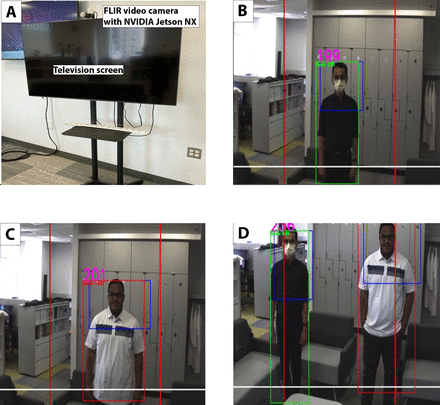In early 2020, before COVID-19 vaccines and effective treatments were widely available, universal mask wearing was a central strategy for preventing the transmission of COVID-19. But hospitals and other settings with mask mandates faced a challenge. Reminding patients, visitors and employees to wear masks needed to be done manually, which was time consuming and labor intensive.
Researchers from Brigham and Women’s Hospital (BWH), a founding member of the Mass General Brigham healthcare system, and Massachusetts Institute of Technology (MIT) set out to test a tool to automate monitoring and reminders about mask adherence using a computer vision algorithm. The team conducted a pilot study among hospital employees who volunteered to participate and found that the technology worked effectively and most participants reported a positive experience interacting with the system at a hospital entrance. Results of the study are published in BMJ Open.
“To change a behavior, like mask wearing, takes a lot of effort, even among healthcare professionals,” said lead author Peter Chai, MD, MMS, of the Department of Emergency Medicine. “Our study suggests that a computer visualization system like this could be helpful the next time there is a respiratory, viral pandemic for which masking is an essential strategy in a hospital setting for controlling the spread of infection.”
“We recognize the challenges in ensuring appropriate mask usage and potential barriers associated with personnel-based notification of mask misuse by colleagues and here we describe a computer vision-based alternative and our colleagues’ assessment of initial acceptability of the platform,” said senior author C. Giovanni Traverso, MB, BChir, PhD, of the Department of Medicine at BWH and in the Department of Mechanical Engineering at MIT.
For the study, the team used a computer vision program that was developed using lower resolution closed circuit television still frames to detect mask wearing. Between April 26, 2020 and April 30, 2020, researchers invited employees who were entering one of the main hospital entrances to participate in an observational study that tested the computer vision model. The team enrolled 111 participants who interacted with the system and were surveyed about their experience.
The computer visualization system accurately detected the presence of mask adherence 100 percent of the time. Most participants—87 percent—reported a positive experience interacting with the system in the hospital.
The pilot was limited to employees at a single hospital and may not be generalizable to other settings. In addition, behaviors and attitudes toward masking have changed throughout the course of the pandemic and may differ across the United States. Future study is needed to identify barriers to implementing computer visualization systems in healthcare settings versus other public institutions.
“Our data suggest that individuals in a hospital setting are receptive to the use of computer visualization systems to help detect and offer reminders about effective mask wearing, particularly at the height of a pandemic as a way to keep themselves safe while serving on the front lines of a healthcare emergency,” said Chai. “Continued development of detection systems could give us a useful tool in the context of the COVID-19 pandemic or in preparation for preventing the spread of future airborne pathogens.”
Disclosures: Traverso has a financial interest in Teal Bio, a biotechnology company making transparent and reusable respirators. Adam Landman is a member of the Abbot Medical Device Cybersecurity Council. No other authors have competing interests to report.
Reference: Chai PR et al. “The acceptance of a computer vision facilitated protocol to measure adherence to face masks: a single site, observational cohort study among hospital staff” BMJ Open DOI: 10.1136/bmjopen-2022-062707
Source: BMJ Open
